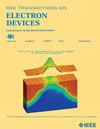基于机器学习紧密结合框架的10纳米WSi2N4 mosfet的性能研究
IF 2.9
2区 工程技术
Q2 ENGINEERING, ELECTRICAL & ELECTRONIC
引用次数: 0
摘要
单层WSi2N4已成为一种有前途的用于高性能超尺度mosfet的二维半导体。在这项工作中,我们使用机器学习技术来生成稀疏紧密结合(TB)哈密顿量,并评估以天然Si3N4作为栅极介电介质的亚10nm n型和p型WSi2N4 mosfet的性能。为了验证我们的方法,我们将机器学习TB (MLTB)模型生成的I-V特征与使用单层HfS2 MOSFET的最大局部化万尼尔函数(MLWF)方法从TB模型获得的特征进行了比较,证明了非常好的一致性。我们的研究结果表明,n型和p型WSi2N4 mosfet都满足5-10 nm通道长度(${L}_{\text {ch}}$)的高性能(HP)应用的国际器件和系统路线图(IRDS) 2022导通电流(${I}_{\text {on}}}$)目标。对于高密度(HD)应用,n型和p型器件可以分别缩小到7 nm和8 nm,同时保持IRDS合规性。在10nm通道长度下,n型器件比p型器件实现更高的${I}_{\text {on}}$,而两者在室温下都表现出接近60 mv /dec极限的亚阈值摆幅(SS)。然而,随着${L}_{\text {ch}}$的减小,由于增强的源漏隧道效应,n型器件比p型器件经历更大的SS退化,从而使p型器件在更短的信道长度下表现更好。此外,输运模拟揭示了WSi2N4的方向各向同性载流子行为。这些发现强调了WSi2N4在下一代超大尺寸晶体管中的潜力,并展示了基于机器学习的方法在用新型二维材料构建的设备建模中的实用性。本文章由计算机程序翻译,如有差异,请以英文原文为准。
Investigating the Performance of Sub-10-nm WSi2N4 MOSFETs With Native Dielectric Through a Machine Learning Tight-Binding Framework
Monolayer WSi2N4 has emerged as a promising 2-D semiconductor for high-performance ultrascaled MOSFETs. In this work, we use machine learning techniques to generate a sparse tight-binding (TB) Hamiltonian and evaluate the performance of sub-10-nm n-type and p-type WSi2N4 MOSFETs with native Si3N4 as the gate dielectric. To validate our approach, we compare the I–V characteristics generated by our machine learning TB (MLTB) model with those obtained from a TB model using the maximally localized Wannier function (MLWF) approach for a monolayer HfS2 MOSFET, demonstrating excellent agreement. Our results show that both n-type and p-type WSi2N4 MOSFETs meet the International Roadmap for Devices and Systems (IRDS) 2022 on-current ( ${I}_{\text {on}}$ ) target for high-performance (HP) applications at channel lengths ( ${L}_{\text {ch}}$ ) of 5–10 nm. For high-density (HD) applications, n-type and p-type devices can be scaled down to 7 and 8 nm, respectively, while maintaining IRDS compliance. At a 10-nm channel length, n-type devices achieve a higher ${I}_{\text {on}}$ than p-type devices, while both exhibit comparable subthreshold swing (SS) close to the 60-mV/dec limit at room temperature. However, as ${L}_{\text {ch}}$ decreases, n-type devices experience greater SS degradation than p-type devices due to enhanced source-to-drain tunneling, allowing p-type devices to outperform at shorter channel lengths. In addition, transport simulations reveal directionally isotropic carrier behaviors in WSi2N4. These findings underline the potential of WSi2N4 for next-generation ultrascaled transistors and showcase the utility of machine-learning-based approaches in modeling devices constructed with novel 2-D materials.
求助全文
通过发布文献求助,成功后即可免费获取论文全文。
去求助
来源期刊

IEEE Transactions on Electron Devices
工程技术-工程:电子与电气
CiteScore
5.80
自引率
16.10%
发文量
937
审稿时长
3.8 months
期刊介绍:
IEEE Transactions on Electron Devices publishes original and significant contributions relating to the theory, modeling, design, performance and reliability of electron and ion integrated circuit devices and interconnects, involving insulators, metals, organic materials, micro-plasmas, semiconductors, quantum-effect structures, vacuum devices, and emerging materials with applications in bioelectronics, biomedical electronics, computation, communications, displays, microelectromechanics, imaging, micro-actuators, nanoelectronics, optoelectronics, photovoltaics, power ICs and micro-sensors. Tutorial and review papers on these subjects are also published and occasional special issues appear to present a collection of papers which treat particular areas in more depth and breadth.
 求助内容:
求助内容: 应助结果提醒方式:
应助结果提醒方式:


